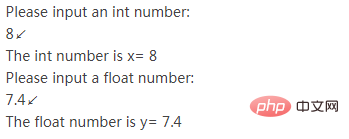What are the input and output statements in C++?
c Input and output statements include: 1. scanf() statement, used to read data input from the keyboard; 2. printf() statement, used to output specified format information to the standard output device; 3. The cout statement represents standard output. When using cout for output, it must be followed by the ">" operator.

The operating environment of this tutorial: Windows 7 system, C 17 version, Dell G3 computer.
In C language, we usually use scanf and printf to input and output data. scanf is used to read data input from the keyboard, and printf is used to output specified format information to the standard output device
In C language, we can still use this set of input and output libraries of C language, but C A new, easier-to-use input and output library has been added.
[Example 1] Simple input and output code example:
#include<iostream>
using namespace std;
int main(){
int x;
float y;
cout<<"Please input an int number:"<<endl;
cin>>x;
cout<<"The int number is x= "<<x<<endl;
cout<<"Please input a float number:"<<endl;
cin>>y;
cout<<"The float number is y= "<<y<<endl;
return 0;
}The running results are as follows (↙ means pressing the Enter key):

Input and output in C can be regarded as a series of data streams. Input can be regarded as a series of data streams input into the program from a file or keyboard, while output can be regarded as a series of data streams output from the program. to the display or file.
When writing a C program, if you need to use input and output, you need to include the header file iostream, which contains objects for input and output, such as the common cin representing standard input, cout represents standard output and cerr represents standard error. iostream is the abbreviation of Input Output Stream, which means "input and output stream".
iostream is the abbreviation of Input Output Stream, which means "input and output stream".
cout and cin are built-in objects of C, not keywords. The C library defines a large number of classes (Class), which programmers can use to create objects. cout and cin are objects of the ostream and istream classes respectively, but they are created in advance by the developers of the standard library. , can be used directly. Such objects created in advance in C are called built-in objects.
When using cout for output, you need to follow the << operator. When using cin for input, you need to follow the
The 6th line of code indicates the output of a string like "Please input a int number:" to prompt the user to enter an integer, where endl represents a new line, and \n in C language has the same effect. Of course, you can also use \n to replace endl in this code, so you have to write:
cout<<"Please input an int number:\n";
endl The last character is the letter "l" , instead of the Arabic numeral "1", it is the abbreviation of "end of line".
The 7th line of code indicates that an int type data is read from the standard input (keyboard) and stored in the variable x. If the user input is not int type data at this time, it will be forced to be converted into int type data.
The 8th line of code outputs the input integer data. From this statement we can see that cout can output continuously. Similarly, cin also supports continuous input of multiple variables, as shown below.
[Example 2] cin continuous input example:
#include<iostream>
using namespace std;
int main(){
int x;
float y;
cout<<"Please input an int number and a float number:"<<endl;
cin>>x>>y;
cout<<"The int number is x= "<<x<<endl;
cout<<"The float number is y= "<<y<<endl;
return 0;
}Run result:

The 7th line of code reads continuously from the standard input Take an integer and a floating-point number (separated by spaces by default) and store them in x and y respectively.
The input operator>> will ignore the space after the previous item before reading the next input item, so there must be a space between the numbers 8 and 7.4. When cin reads 8, it ignores the space. , then read 7.4.
Beginners may find the usage of cout and cin very strange. They are neither function calls like printf() or scanf(), nor keywords. Please keep this question in mind. We will discuss it in " The answer is revealed in the chapter "C Operator Overloading".
The usage of cout and cin is very powerful and flexible. This section shows only the most basic functions. More advanced techniques will be introduced in subsequent chapters. In future C programming, I also recommend you to use cin and cout, which are more flexible and easier to use than scanf and printf in C language.
For more programming-related knowledge, please visit: Programming Teaching! !
The above is the detailed content of What are the input and output statements in C++?. For more information, please follow other related articles on the PHP Chinese website!

Hot AI Tools

Undresser.AI Undress
AI-powered app for creating realistic nude photos

AI Clothes Remover
Online AI tool for removing clothes from photos.

Undress AI Tool
Undress images for free

Clothoff.io
AI clothes remover

AI Hentai Generator
Generate AI Hentai for free.

Hot Article

Hot Tools

Notepad++7.3.1
Easy-to-use and free code editor

SublimeText3 Chinese version
Chinese version, very easy to use

Zend Studio 13.0.1
Powerful PHP integrated development environment

Dreamweaver CS6
Visual web development tools

SublimeText3 Mac version
God-level code editing software (SublimeText3)

Hot Topics
 1378
1378
 52
52
 How to implement the Strategy Design Pattern in C++?
Jun 06, 2024 pm 04:16 PM
How to implement the Strategy Design Pattern in C++?
Jun 06, 2024 pm 04:16 PM
The steps to implement the strategy pattern in C++ are as follows: define the strategy interface and declare the methods that need to be executed. Create specific strategy classes, implement the interface respectively and provide different algorithms. Use a context class to hold a reference to a concrete strategy class and perform operations through it.
 How to implement nested exception handling in C++?
Jun 05, 2024 pm 09:15 PM
How to implement nested exception handling in C++?
Jun 05, 2024 pm 09:15 PM
Nested exception handling is implemented in C++ through nested try-catch blocks, allowing new exceptions to be raised within the exception handler. The nested try-catch steps are as follows: 1. The outer try-catch block handles all exceptions, including those thrown by the inner exception handler. 2. The inner try-catch block handles specific types of exceptions, and if an out-of-scope exception occurs, control is given to the external exception handler.
 How to use C++ template inheritance?
Jun 06, 2024 am 10:33 AM
How to use C++ template inheritance?
Jun 06, 2024 am 10:33 AM
C++ template inheritance allows template-derived classes to reuse the code and functionality of the base class template, which is suitable for creating classes with the same core logic but different specific behaviors. The template inheritance syntax is: templateclassDerived:publicBase{}. Example: templateclassBase{};templateclassDerived:publicBase{};. Practical case: Created the derived class Derived, inherited the counting function of the base class Base, and added the printCount method to print the current count.
 What is the role of char in C strings
Apr 03, 2025 pm 03:15 PM
What is the role of char in C strings
Apr 03, 2025 pm 03:15 PM
In C, the char type is used in strings: 1. Store a single character; 2. Use an array to represent a string and end with a null terminator; 3. Operate through a string operation function; 4. Read or output a string from the keyboard.
 Why does an error occur when installing an extension using PECL in a Docker environment? How to solve it?
Apr 01, 2025 pm 03:06 PM
Why does an error occur when installing an extension using PECL in a Docker environment? How to solve it?
Apr 01, 2025 pm 03:06 PM
Causes and solutions for errors when using PECL to install extensions in Docker environment When using Docker environment, we often encounter some headaches...
 How to handle cross-thread C++ exceptions?
Jun 06, 2024 am 10:44 AM
How to handle cross-thread C++ exceptions?
Jun 06, 2024 am 10:44 AM
In multi-threaded C++, exception handling is implemented through the std::promise and std::future mechanisms: use the promise object to record the exception in the thread that throws the exception. Use a future object to check for exceptions in the thread that receives the exception. Practical cases show how to use promises and futures to catch and handle exceptions in different threads.
 Four ways to implement multithreading in C language
Apr 03, 2025 pm 03:00 PM
Four ways to implement multithreading in C language
Apr 03, 2025 pm 03:00 PM
Multithreading in the language can greatly improve program efficiency. There are four main ways to implement multithreading in C language: Create independent processes: Create multiple independently running processes, each process has its own memory space. Pseudo-multithreading: Create multiple execution streams in a process that share the same memory space and execute alternately. Multi-threaded library: Use multi-threaded libraries such as pthreads to create and manage threads, providing rich thread operation functions. Coroutine: A lightweight multi-threaded implementation that divides tasks into small subtasks and executes them in turn.
 How to calculate c-subscript 3 subscript 5 c-subscript 3 subscript 5 algorithm tutorial
Apr 03, 2025 pm 10:33 PM
How to calculate c-subscript 3 subscript 5 c-subscript 3 subscript 5 algorithm tutorial
Apr 03, 2025 pm 10:33 PM
The calculation of C35 is essentially combinatorial mathematics, representing the number of combinations selected from 3 of 5 elements. The calculation formula is C53 = 5! / (3! * 2!), which can be directly calculated by loops to improve efficiency and avoid overflow. In addition, understanding the nature of combinations and mastering efficient calculation methods is crucial to solving many problems in the fields of probability statistics, cryptography, algorithm design, etc.




